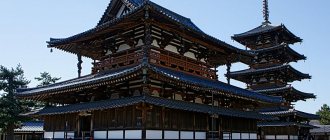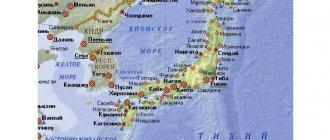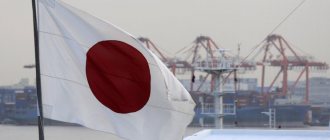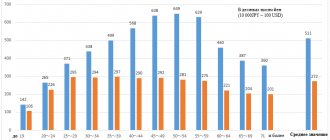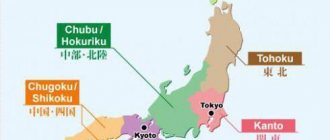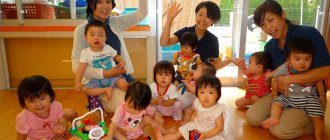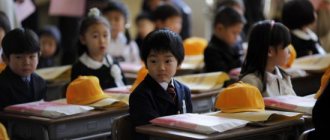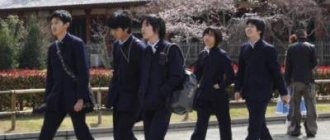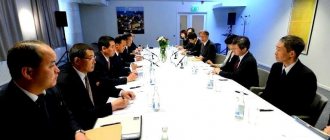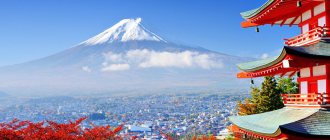Japan, which is also commonly called the Land of the Rising Sun, is a relatively small island state located in the Pacific Ocean. The country is located on an archipelago, which is characterized by mountainous terrain. The main islands are: Kyushu, Honshu, Hokkaido and Shikoku. The population density is significant, since 126 million people are concentrated in a small area. Now it is the tenth place in the world. However, the population is gradually declining, which also affects the economy of this state.
Economy
In short, Japan's economy is one of the most developed in the world. It is in third or fourth place in terms of GDP. Characteristic is the high standard of living of the population, which sharply contrasts with the small size of the Japanese apartments. Japan is sadly different from other countries in that it is the only country in the world that has experienced the use of nuclear weapons.
Japanese currency is the yen.
EREPORT.RU
The Japanese economy is one of the most developed economies in the world. In terms of GDP and industrial production, Japan ranks third among countries in the world, after the United States and China. High technologies (electronics and robotics) are developed. Transport engineering is also developed, including automotive and shipbuilding, and machine tool manufacturing. The fishing fleet makes up 15% of the world's. Agriculture is subsidized by the state, but 55% of food (calorie equivalent) is imported. There is a network of Shinkansen and expressways.
The economic mechanism that emerged after the Second World War was aimed at high growth rates of the Japanese economy, the unique features of which allow us to speak of a special model.
Features of the structure of private entrepreneurship
Japan has a different social structure from other Western countries, characterized by the dualism of modern industry. The main place in employment and production of the manufacturing industry belongs to small and medium-sized enterprises. At the same time, the share of small enterprises does not show a clearly expressed tendency to decrease. Against the backdrop of a mass of small companies, the concentration of capital in heavy industry quickly developed, which led to the formation of giant associations.
A feature of the economic system is the vertical integration of firms, their grouping, which permeates the entire system of business relations in the country. There are two levels or types of formation of economic groupings. The first is traditional for most Western countries. It is based on the intertwining of capital and personal union. The uniqueness of the Japanese economic system is determined by the presence of groups (keiretsu), which are associations of large companies with small and medium-sized ones, based on various types of connections, the main ones being production ones, determined by the parent companies.
Over 60% of small and medium-sized manufacturing companies are covered by subcontracting relationships. The peculiarity of this practice is the long-term nature of connections, which predetermines its unified organizational character. Nowadays, practically no large industrial company exists as a single legal entity. Unlike the “two-layer” structure of other Western countries (market - enterprise), the Japanese economic system has three layers (market - group of enterprises - enterprises themselves). The subordination rather than the takeover of small and medium-sized firms was facilitated by legislation that limited the process of centralization of capital by requiring the unanimous consent of the directors of subordinate companies. In addition to production ties, the structure of the group is cemented by other types of dependencies: participation of the parent company in the capital of dependent companies, sending representatives of the parent company to the directorates of companies, and provision of various types of services. As a result, depending on the intensity of production and other connections, each keiretsu represents a multi-layered, extremely heterogeneous structure and at the same time very flexible, where there is a set of connections from extremely rigid to very weak. The most common form of communication is vertical.
It is not uncommon for large companies to have several groups when production and distribution functions are combined. In this case, trading companies are located between the parent company and a network of retail stores. They are usually its subsidiaries and are involved in organizing sales of the parent company's products. Parent companies support stores with resources through trading companies and reward them for maintaining prices for the parent company's products. Due to the fact that keiretsu are not a strictly dependent organization, such as vertically integrated corporations in the United States, but a set of strong and weak relationships, centripetal and centrifugal tendencies, this allows them to more easily adapt to the requirements of the external environment.
A market within a group operating on such a basis is more profitable for all its participants than a free market for personal goods. There is a lower risk level and lower transaction costs. Small enterprises have lower wages. This is one of the reasons why the country maintains significant differences in wage levels between large, medium and small companies. On average, wages at the latter are about 60% of the wages of those employed at large enterprises.
In connection with the processes of globalization, the production of the largest keiretsu companies is experiencing a period of significant organizational restructuring with the emergence of new units in their composition. These changes are aimed at finding the optimal combination, as far as possible, of non-market relationships between companies within the group with the freedom of action of grouped firms to ensure the effective functioning of the group as a whole.
The interweaving of capital and industrial vertical integration in the form of keiretsu led to the creation of financial groups that took dominant positions in the economy. They are usually managed by large banks, universal trading and industrial companies. Some of the financial groups grew out of the pre-war zaibatsu. These are “Mitsui”, “Mitsubishi”, “Sumitomo”, “Fue”, as well as “Daniti Kange”, “Sanwa”.
Financial capital groups are characterized by mutual ownership of shares in participating companies, but each of them owns a relatively small stake in other companies. For example, financial institutions can own no more than 5%, and life insurance companies can own no more than 10% of the firms' shares. Companies cannot own their own shares. As a result, there is a clear transfer of control over companies from individuals to legal entities (1960 - 70%, 1986 - 76.1% of shares). The role of individual capital in the social structure of industry and the credit sector has decreased. Individual ownership in the form of shares accounts for only 1% of operating capital. In relation to the amount of corporate net profit, the share of dividends decreased from 60% in 1936 to 10.5% in 1990. In fact, in Japan there was a clear tendency to form a model of economic self-government without connecting it with shareholder ownership.
Legal entities acquire shares to ensure stability of ties with certain companies. The establishment of long-term connections between banks and companies is ensured not only through mutual ownership of shares, but also through lending. Large debts to banks were a characteristic feature of the functioning of Japanese corporations. Relations in financial capital groups are built on the principles of hierarchy. The interweaving of interests and the hierarchical nature of relations between private traders lead to the fact that in the markets the group acts as a united front. This is facilitated by a specific system of lending to companies, which was created at the first stage of post-war development. This financing system allowed companies, in particular large export firms, to obtain the necessary funds at a relatively low cost and expand the scale and efficiency of production. The essence of this system was that, under guarantees from the Ministry of Finance and the Bank of Japan, commercial banks provided maximum loans to large companies. The system provided extremely stable conditions for the companies' business activities financially. The system of mutual holding of shares almost completely removes companies from the influence of fluctuations on the stock exchange and external purchase of shares.
This system of indirect financing reduces the need to release one's funds to the capital market. With direct financing through the credit market, the structure of production and management must ensure a high level of profits in order to attract investors. With indirect financing by banks, it is not high profits that are important, but a strategy for expanding their market share, since banks expect to continue to receive large loans that involve large payments on them. In addition, mutual ownership of shares implies mutual settlement, and hence high dividends become meaningless. In the interests of enterprise development, it is more important to increase internal reserves and capital investments, and increase income from rising share prices.
In Japan, shares that companies hold as their assets are registered at book value, so if the value of shares on the securities market significantly exceeds the book rate, this accordingly increases the hidden assets of firms, giving them the opportunity to disregard shareholders and control authorities make investments based on long-term interests.
As a result, Japanese entrepreneurs have more freedom than entrepreneurs in other Western countries. There are few representatives from the outside world on company boards here; shareholder meetings are formal. The Japanese management and credit system and the situation in the credit markets encouraged companies to effectively use profits, lower dividends and thus increase their internal reserves. On the other hand, it facilitated the free implementation of long-term capital investments by obtaining large bank loans.
Labor Relations
One of the characteristic features of the Japanese model of economic development is the use of national traditions and characteristics of the workforce. The principle of lifelong employment has been promoted in the country for a long time. Large companies that are able to build a personnel pyramid and provide employment have greater opportunities to implement this principle, unlike small and medium-sized firms. It is clear that there are no clear rules either in companies or in legislation that establish guarantees of employment for life. At the same time, both employees and management tacitly consider long-term work as a clause in the collective agreement.
The government, in an effort to support employment through a subsidy system, also has in mind the principle of continuously working in one place for many years. Consequently, in practice the essence of the problem, compared to other countries, comes down simply to longer hiring periods. In 1981, the share of workers who quit was 16%. This meant that within three years half of the workforce would quit their jobs. This mainly occurs at young ages. Permanent workers make up 20-30% of the workforce.
The salary level was set depending on the length of service. She grew most rapidly in middle age. At the same time, various additional payments to the base rate were widely used.
Labor relations are built on the philosophy “the company is our common home.” Labor utilization is mainly based on the concept of “human potential”. Back at the turn of the 60s and 70s, a number of Japanese companies came to the conclusion that an employee receives the greatest satisfaction if his work is more holistic and diverse. Then, assembly operations began to abandon conveyor lines and replace them with rotating tables, at which either a whole product or a large block of it is assembled by one worker. The employee determines the specifics and schedule of work, elements of quality control, costs, safety, etc. As a result of strengthening technological operations, defects decreased from 6 to 0.3%, labor productivity increased by 20%, and production costs decreased by 30%.
The basis of organization and management in this approach was small self-governing groups. They cover the entire enterprise vertically and horizontally. Each group is placed in conditions that stimulate the improvement of its activities and the constant search for ways to use equipment economically. The group participates in making decisions concerning the firm as a whole or its divisions if these decisions affect this group.
The female workforce occupies a unique position in labor relations. The management of many companies views female staff as purely “expendable.” Women are usually employed as maids and hourly workers. Women day laborers most often serve as a kind of valve for the administration of companies. In unfavorable economic conditions, this category of workers is the first to be laid off. In government statistics, female day laborers are classified as housewives, so when they lose their jobs, they are not included in the number of unemployed. This simple technique helps keep official unemployment figures low. The average salary of Japanese women is half that of men.
Japan is characterized by long working hours. On average, a man spends 57.7 hours a week at work, 10 hours more than Americans and Western Europeans.
The longer work week is largely determined by the wage system, which is divided into three categories: base rate, overtime and bonus. The base rate is usually set as low as possible, and overtime and bonuses, which can be varied more freely, are used as "buffer pay". They increase during periods of good economic conditions and decrease during recessions, when belts are tightened. This payment system is very effective in avoiding bankruptcies. There are no sharp pay gaps across companies. After taxes, the average managing director's salary is about 10 times what the lowest paid worker earns, compared with the US average of 100 times.
The system of labor utilization, together with the multi-stage structure of production organization, functioned extremely efficiently and was a source of competitive strength. It contributed to the frequent rotation of personnel at the initial stage of their career, which was conducive to the rapid assimilation of the company's behavioral style and the establishment of informal relationships among different groups of the same organization. Making decisions based on the consent of all parties was a tool for disseminating information and accepting responsibility for the affairs of the company among various people. Constant control by senior managers minimized possible errors. But such a system complicated the control apparatus and made it cumbersome.
Role of the State
The peculiarity of the economic model is the unity of the state apparatus and big capital in solving common problems. There is still a high level of coordination between industrial, trading, banking companies and the government. State entrepreneurship in the post-war period occupied a modest place. The country widely uses a system of national, regional, target, sectoral and intra-company planning. At the national level, a whole system of plans, forecasts, and indicative programs is being developed, indicating the main and desirable guidelines for economic and social development for society as a whole. Due to the small share of the public sector, national plans are aimed mainly at regulating the activities of private firms. The main goals and objectives of national economic development plans are specifically embodied in the content of internal corporate plans, which are of a directive nature. This creates a complex interconnected planning system. Internal corporate plans, in turn, are also taken into account when developing national programs through a mechanism of consultation with the largest private associations, Dukay, Nikkeiren, as well as with relevant associations and financial and industrial groups.
The system of national plans consists of five groups of plans - a plan for economic and social development, a plan for the development and use of land, rational allocation of productive forces, sectoral plans, targeted national programs and regional planning. Plans and programs, despite their indicative nature, are supported by a wide arsenal of financial, legal and organizational means that ensure their significant effectiveness and feasibility. National economic plans are a kind of state investment programs recommended and supported by the economic and social resources of the entire state.
Agriculture, based on small farms, developed under conditions of government regulation and broad support. Wage labor and rental relations are not widespread here. Only 7% of farms have more than 2 hectares of land, and 70% of all farms receive their income outside the industry, mainly in industry and the service sector. Owners of small plots of land work on their farms only on holidays and weekends. The state is a monopoly buyer of many types of agricultural products at prices above world prices. This support creates an artificial climate for the industry. An important place in the regulatory system is occupied by interest rates and foreign exchange controls with the separation of domestic and world markets. The Policy Committee of the Bank of Japan (the bank's highest decision-making body) set deposit and lending rates within a minimum range. Deposit interest for each type, short-term interest and the entire system of interest rates tied to it followed the movement of the official discount rate. Along with the quantitative limitation of bank lending, until the early 70s, this made it possible to effectively implement direct monetary regulation, as well as to underestimate the costs of raising funds by banks and, to a certain extent, capital costs of companies. In the 70s, the liberalization of interest rates in financial markets began, which included not only the release of loan interest, but also interest on deposits and other instruments for raising funds by banks and enterprises, which had long been set at a reduced level.
The uniqueness of the Japanese economic model is also complemented by the role of senior officials. According to accepted custom, their instructions are binding on firms. If someone violates them, for edification, one company is punished, but severely. As we can see, the considered economic model is built on a significant limitation of the action of market forces. Until the end of 1993, according to the Fair Deals Commission, up to 40% of all manufactured products were subject to certain restrictions and government regulation. Based on economic and administrative principles of management, the state was able to effectively implement the policies developed with the participation of business circles.
Over the past decades, Japan's economic model has undergone gradual changes from a "semi-state" model to a more open one based on market principles. Thus, many industrial companies switched to the principle of direct financing (issuing securities, especially shares and other instruments). In 1981-1985. The issue of shares and other instruments, such as convertible and guaranteed securities, accounted for 1/4 of the funds mobilized by firms. In 1989 they already exceeded 70%. However, all this time, government bodies, in particular the Ministry of Finance of Foreign Trade and Industry, performed the functions of administrative regulation of economic entities and their protectionist and paternalistic protection, paying primary attention to the stability of the economic environment.
Other articles in the section “World Economy”
Geographical features
Japan is located in very difficult natural conditions. It is separated from the mainland, a significant part of the area is occupied by mountains. The Japanese archipelago is in a zone of seismic and tectonic instability, which often causes damage to both the economy and people's lives. The accident at the Fukushima-1 nuclear power plant had an extremely negative impact on the economic and environmental well-being of the country.
Another disadvantage is the climatic conditions. Typhoons and tropical hurricanes visit here frequently, often causing destruction and economic damage. Japan has few minerals, especially fuels, which the country is forced to import. The lack of free space limits opportunities for the development of renewable energy, and the construction of new nuclear power plants has not been carried out since the 2011 accident. The advantage is the large expanses of ocean waters where fish and seafood are harvested.
Among the minerals in the depths of Japan, sulfur is the leader.
Specifics of Japanese education
One of the key tools that Japan's economic model uses is the national education of the residents of this East Asian country. Its specificity is due to the very aggressive natural conditions of Japan, its ancient and difficult history, unique philosophical views, religious and cultural traditions, and moral values.
The main features of Japanese education are: very strict discipline, great respect and love for work, the desire for maximum accuracy and pedantry, and reverence for the older generation. The Japanese develop such character traits as perseverance, perseverance, patience, the ability to obey, loyalty to the employer, collectivism and teamwork at work. In Japanese society, each individual must occupy the place allotted to him, not expand the range of his needs unnecessarily, and strive to improve the level of education and self-development.
Attitude to ecology
The Japanese economy is developing in close connection with the environment. After a surge in pollution in the 50s and 60s of the 20th century, since 1970 the country has been steadily moving towards abandoning dirty technologies and improving the quality of the environment. The main priority is energy efficiency. This is also due to the fact that the country has few fuel resources of its own. and Toyota have long been improving their products, making cars less dependent on fossil fuels. The country makes stringent commitments to reduce greenhouse gas emissions.
"Golden 60s"
A period of rapid economic growth between 1955 and 1961 paved the way for the so-called "Golden Sixties", the second decade of which is usually associated with the "Japanese economic miracle" . In 1965, Japan's nominal GDP was valued at slightly more than $91 billion. Fifteen years later, in 1980, nominal GDP soared to a record $1.065 trillion.
The volume of Japanese exports increased almost tenfold between 1957 and 1973. Japan literally bombarded the world with cars, ships, optics, electrical equipment, sewing machines, radios, cameras and televisions. For a number of important types of products, Japan has taken second place after the United States. At the same time, Japan, dependent on the export of raw materials and fuel, imported unprocessed raw materials and carried out a full cycle of its processing.
During the same period, road and sea transport actively developed. Each of them accounted for 40% of domestic cargo transportation. By 1971, Japan had become one of the largest automobile countries in the world, with over 12 million cars, and the total tonnage of the maritime fleet (including giant tankers) exceeded 30 million tons. In both industries, this was the second highest figure in the world after the United States.
As a result, during the period from 1950 to 1973, the average annual growth rate of the Japanese economy was about 10-11%. This was the highest rate among developed countries. The record economic growth that began in the mid-1950s continued until the oil crisis of 1973, during which time Japan's GDP increased 6.5 times, and industrial production more than 10 times.
This historical phenomenon will be further characterized as the Japanese Economic Miracle .
Rapid growth rates in the shortest possible time allowed Japan not only to fully recover after defeat in the war, but also to take second place in economic power, consistently surpassing France, Italy, Canada, Great Britain, Germany, the USSR and second only to the United States.
The distinctive features of the “Japanese Economic Miracle” were:
- the unification of manufacturers, resource suppliers, product distributors and banks into closely related groups called keiretsu - large corporate conglomerates and holdings;
- mutually beneficial relations between entrepreneurs and the government;
- guarantee of lifetime employment in large corporations;
- active trade union movement.
Economic indicators
Briefly speaking about the Japanese economy, it is developing steadily, demonstrating annual GDP growth and the development of high-tech technologies. The amount of inflation in this country is minimal and rarely exceeds 1% per year. The reverse process – deflation – is often observed. The country's GDP growth is about 1% per year. Unemployment is gradually decreasing and fell to 2.5% in 2021. Japanese banks correspond to the level of highly developed countries.
Japan after the war
In the first half of the 20th century, Japan pursued a policy of militarism and expansion.
The Japanese tried to compensate for the lack of natural resources by seizing the territories of a number of East Asian countries. But as a result of World War II, the Land of the Rising Sun suffered a crushing defeat and, after nuclear attacks on Hiroshima and Nagasaki on September 2, 1945, was forced to sign the Act of Unconditional Surrender. The country was occupied by “allied forces.”
During the war, a significant part of the Japanese economic potential was destroyed, the housing stock was significantly destroyed, and supplies of foreign raw materials ceased. Industrial production fell to 1926 levels, and total damage was estimated at 1.3 trillion. Ian. The country's development was delayed for a good ten years.
Product manufacturing
In Japan, the mining sector is poorly developed, and the production of products with high added value predominates. In the first place are cars and spare parts for them. This direction is traditional for Japan, and the quality of products meets recognized standards. Japanese cars are also distinguished by their durability. Production was especially profitable until the 90s. 20th century, and then competition intensified, first with the United States and then with Asian countries, especially China. Currently, the Chinese auto industry is introducing new technologies faster than the Japanese one. There they are more actively switching to electric vehicles, constantly improving their characteristics. Japan has traditionally placed emphasis on economical gasoline engines, achieving great success in this matter. This is especially true for cars of the Japanese brand Toyota, which became famous throughout the world for the production of economical internal combustion engines and was considered the standard of environmentally friendly transport. Now, electric cars are considered the most environmentally friendly, and in this area Japan is far from a leader.
The production of household and computer appliances, microcircuits and equipment plays a major role. The metallurgy and chemical industries, including the production of petroleum products, are quite developed.
Features of the structure of Japan's exports and imports
Japan takes an active part in international trade. The main exports of the state are vehicles. In terms of sales abroad of products in this category, Japan ranks 2nd in the world rankings (after Germany).
The article “Japanese car auctions: affordable quality” will tell you how you can purchase a high-quality Japanese-made car.
Electrical machines, mechanical devices and equipment are also important components of Japanese exports. The total volume of sales of these types of goods (including cars) to other countries is 55% of the total cost of supplies to other countries.
The main markets are Germany, Australia, countries of Southeast and East Asia, and the USA. As for Russia, in terms of exports from Japan it is in the third ten among all countries in the world. Moreover, in value terms, the majority of exports to the Russian Federation are vehicles.
The main product groups imported into Japan are petroleum products and mineral fuels. According to data at the beginning of 2021, they were supplied mainly from:
- Russia – 6.8%:
- Qatar – 7.7%;
- United Arab Emirates - 14.1%;
- Australia - 18.2%;
- Saudi Arabia - 18.9%.
Japan also imports electrical machines, mechanical devices and equipment. About half of these goods traditionally come from China. In general, products from the Middle Kingdom account for about 25% of the value of total imports to the Japanese market.
Trade
If we talk briefly about the Japanese economy, this country has important trade relations with the USA, China, South Korea, and Australia.
However, the current situation with the export of Japanese products is quite unfavorable. This is due to growing competition from China and partly Europe and the USA. Japanese products are more expensive than their competitors. This is due to a shortage of raw materials, fuel, space and high employee salaries. Therefore, the country's GDP growth is very slow, but the situation is stable. And the presence of a deflationary trend motivates people to accumulate money, which reduces purchasing activity.
Pros and cons of the Japanese economy in brief
The positive aspects include:
- advanced technologies;
- the presence of a safety margin and a high standard of living of people;
- production and sale worldwide of high quality products with high added value.
The disadvantages are:
- large public debt compared to GDP;
- weak consumer demand within the country (supply dominates);
- deflation and excessively high wages;
- lack of own resources that have to be imported;
- age structure of the population.
The country's authorities are trying to reduce the negative impact of negative factors on the Japanese economy, but so far the measures taken have not changed the situation radically, and the public debt is only growing. This is also reflected in Japan's budget.
Specifics of Japanese management
The Japanese are characterized by the desire to work all their lives in one company, making a career in it. A new employee, no matter what education he has, begins his career from a lower position, but changes his position every two to three years.
Jobs in Japan are not strictly classified. There are no set salary rates for individual specialties. As a rule, these issues are regulated by the head of the company.
Seniority plays a big role in the amount of earnings in Japanese organizations. A manager's salary is determined primarily by the overall performance of the company. The incentives for Japanese workers to work actively are:
- salary growth;
- receiving awards, bonuses;
- receiving one-time benefits;
- receiving large severance payments.
Twice a year, employees receive special payments, the amount of which (usually very large amounts) is determined by the results of the enterprise. This is a very effective incentive tool. Psychological incentives include open conversations with employees and support for initiative. This allows a person to feel that he belongs to a common cause.
Another specific feature of the Japanese management model is the so-called “quality circles”. There are about 1 million of them in the country, and the total number of participants reaches 10 million. As a rule, one circle consists of no more than 10 employees of the enterprise. From time to time they hold meetings to discuss their initiatives, issues of reducing costs, optimizing production, and increasing productivity. Members of the circle who made the best innovation proposals receive memorable souvenirs or cash incentives as a reward.
